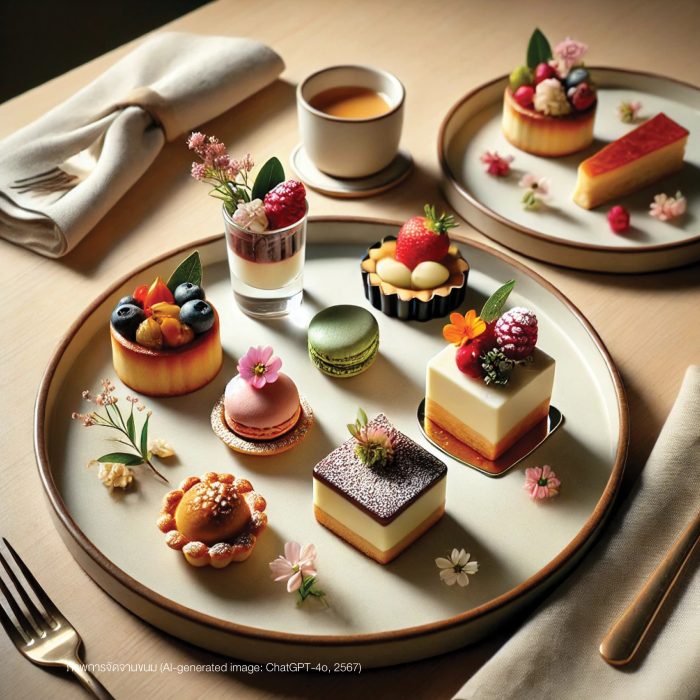
To end the meal, a sweet dessert such as pineapple in syrup or seasonal fruits is traditionally served to refresh the palate after a rich and savory dish, in line with Islamic culinary customs. Sriracha or Pattawia pineapples, known for their perfect balance of sweet and sour flavors, are ideal for this purpose. The juicy flesh of the pineapple provides a refreshing and satisfying finish, enhancing the overall dining experience.
Kreung Wan, or Thai sweet dishes, are more difficult to prepare than foods, requiring greater skill, time, and attention to detail. In the past, desserts were considered luxurious, particularly among the upper class, who enjoyed them as palate cleansers after a meal. This practice gave rise to the phrase “Eat savory food, not sweet,” reflecting the rarity of desserts. Sugar, a key ingredient, was once expensive and difficult to obtain, making it a luxury not commonly found in every household. As a result, desserts rich in sugar were typically reserved for the wealthy or nobility, while ordinary people seldom had the opportunity to enjoy them.
As sugar became more widely accessible, numerous desserts emerged with sugar as a primary ingredient, particularly those from the Thong family, introduced by Thao Thong Khip Ma (the female cook in the Ayutthaya period). These include well-known sweets such as Thong Yip, Thong Yod, and Foi Thong. In Thai culture, desserts thus evolved to hold a significant place not only in terms of taste but also in the broader promotion and completion of the food culture.
As can be seen, the Thai food sets emphasize Thai culture of sharing and the joy of communal dining. The diverse range of ingredients and sweet, salty, sour, and spicy flavors highlights the wisdom of utilizing local resources effectively. In addition to its main dishes, Thai cuisine also includes snacks, comparable to the English tradition of afternoon tea, both of which foster social interaction and reflect cultural values. Thai snacks typically emphasize informality and sharing, mirroring the friendly and generous nature of the Thai people. In contrast, English teatime is more formal, reflecting the importance of social customs and etiquette in that culture.
The variety of Thai snacks reflects not only the wisdom of utilizing local ingredients but also the creativity in cooking, a cultural heritage passed down through generations. These snacks play a central role in festivals and traditional events, contributing to shared experiences and the creation of lasting memories. Today, Thai snacks have gained international popularity, serving as cultural ambassadors that introduce Thai identity and flavors to the world. Examples of these snacks include Miang Kham (wild betel leaf wrap), Sai Krok Pla Naem (shredded fish sausage), Ma Haw (galloping horses appetizer), Pun Klib Sai Pla (fried dumpling with fish filling), Chor Muang (stuffed-dumpling) , Sa Kuu Sai Mhoo (tapioca balls with pork filling), Pla Haeng Taeng Mo (watermelon with sweet dried fish), Khao Tang Nha Tang (crispy rice cracker), and Satay (meat skew), among others.
At present, many traditional Thai food sets are gradually fading due to social changes and shifts in lifestyle, particularly in urban areas. Smaller family sizes make preparing a variety of dishes at once less practical. Additionally, time and space constraints have led to a rise in the popularity of ready-made meals and dining out. Despite this decline in traditional home-cooked food sets, the principle of balancing flavors remains central to how Thais approach food. Whether ordering in restaurants or purchasing food to eat at home, they continue to prioritize variety and flavor harmony. This demonstrates that while the form of Thai food culture has evolved with modern life, its core essence endures.
